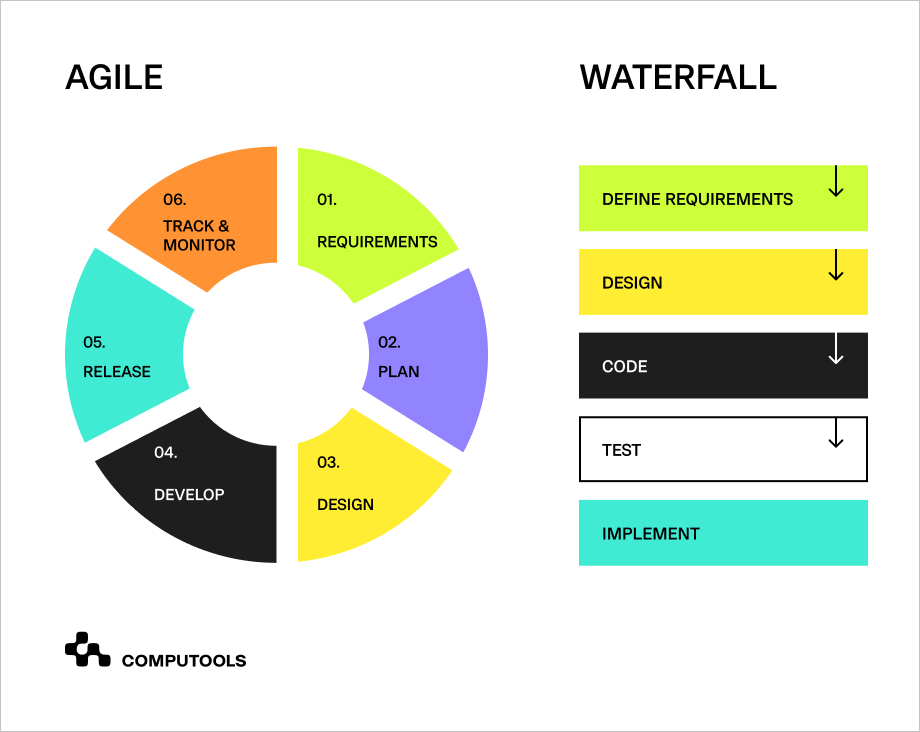Developing software solutions is a complex and effort-consuming process. There are different ways how development companies approach software design. They are called project management methodologies and each method imposes a number of rules developers need to follow since the initiation of development.
Computools essentially relies on two most popular methodologies when creating IT solutions for clients, such as Agile and Waterfall, at times mixing them in the Agile-Waterfall hybrid model, if necessary. Let’s look at each project development method to learn more about its value to stakeholders.
WATERFALL
Waterfall is a slightly outdated methodology of software development. It is driven by sequential execution and requires developing a software solution in a linear order. A waterfall project’s phases flow into each other, making it very difficult to change the scope of work or features once the project has entered the engineering phase. Besides, Waterfall is a document-centric approach and demands a clear functional specification that developers cannot deviate from. This project management method is quite rarely applied to projects at Computools due to its rigidity. You should make major decisions about your product at the initiation and planning phase. This is often seen as a strong disadvantage. Very few customers have the complete view of their product at the very start. So, if you, as Product Owner, want to change the requirements along the way, Waterfall is the least desirable method to stick to.
AGILE
The Agile methodology is predominantly selected for most projects at Computools. Agile, in essence, is targeted at IT solutions that need to be developed fast but have no clearly defined requirements at early stages.
Here are some essential ideas from the Agile Manifesto that outlines the most important principles of Agile methodology:
• Early and continuous delivery of software increments ensures high customer satisfaction throughout the development
• Changes to software priorities can take place any moment, even before the product release
• Tight collaboration between the engineering team and the client needs to be established. This way, developers can catch up with the client’s requirements and modify the software accordingly
• Working software is the primary measure of progress
• At regular intervals, the team reflects on how to become more effective, then tunes and adjusts its behavior accordingly.
The Agile approach involves a number of frameworks that solve different problems of an IT solution’s owner and stakeholders.

What Agile frameworks are used at Computools?
1. Scrum
Scrum-based development works best for fast-moving and innovative projects. Scrum can be viewed as the most popular framework in the Agile group as it ensures effective use of a customer’s time and budget. It helps the development team deliver software efficiently and in shorter periods of time. The main idea of scrum boils down to breaking down prioritized tasks into equal length sprints (usually 2-4 week cycles). The development team builds your software solution by increments so that by the end of each sprint your product offers more business value to its users. However, mind that Scrum works best for teams with 6 to 10 members. For larger teams, it’s more reasonable to opt for SAFe (Scaled Agile Framework) that organizes the work of multiple teams at the same time. For example, if you’re planning to release a huge IT solution that seeks to automate all of your enterprise’s departments, such as accounting, inventory and stock management, customer interaction, and supply chain management, SAFe could be a good option because you will have several teams working on different parts of your project concurrently.
2. Kanban
Kanban is another common framework in the Agile group, but its focus is shifted to continuous software improvement. In this case, the team’s role is to constantly update your product with new features. From Project Manager’s perspective, the development process is managed on a Kanban visualization board that stores daily tasks and limits the work in progress. This way, engineers do not take more work than they potentially handle. Moreover, the Kanban framework is oriented on revealing bottlenecks and completing prioritized tasks as soon as possible. Computools prefers Kanban over other Agile models when it comes to projects in the maintenance stage or IT solutions without a strict deadline but with a high priority on continuous optimization.
3. Extreme programming (XP)
Extreme programming (XP) is also applied to projects at Computools occasionally. This framework looks to deliver software frequently and in small increments according to your business needs. XP works through short development cycles when each 1-3 weeks the development team should make a release to improve your software that may be already on the market. The advantages of XP is that you keep track of what your team deploys and give your regular feedback on it. The downside is a high speed of development, thus the product is more code-centric and less UX/UI-oriented. Besides, the team at times lacks extra time for supporting documentation while programming. XP often goes along with Scrum or Kanban under Agile methodology, which helps you quickly release your product to the market.
How Computools Approaches Software Engineering
Most projects at Computools are developed under the Scrum methodology. However, before getting down to development, Computools advises to run a Discovery phase intended to create the first version of project documentation. It results from a number of sessions with Business Analysts in which you plan and prioritize the functionality of your system as well as create a shared vision of your product followed by the backlog of features. The Discovery phase is done by the Kanban principles and enables the continuous elicitation of your product requirements. Simply put, the Discovery phase may remind of a Waterfall artifact but outlines your product requirements in a less detailed form, which makes it less expensive and faster to do.
Overall, Computools is always driven by your business needs when selecting a project methodology. If you are ready to start a project at Computools from scratch, you will be provided with a full package of human resources to lead both technical and management processes of your project. Similarly, if you have already come up with your product vision and a list of must-have features to deliver, we will take up software planning and bring it to a successful completion.
If you are thinking of creating your IT project with Computools, don’t hesitate to contact us at info@computools.com to get professional assistance from our tech experts with your project planning and development.

Computools
Software Solutions
Computools is a digital consulting and software development company that delivers innovative solutions to help businesses unlock tomorrow.









“Computools was selected through an RFP process. They were shortlisted and selected from between 5 other suppliers. Computools has worked thoroughly and timely to solve all security issues and launch as agreed. Their expertise is impressive.”